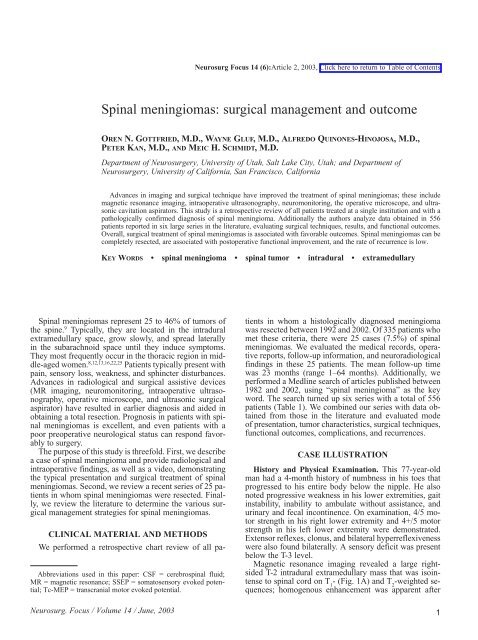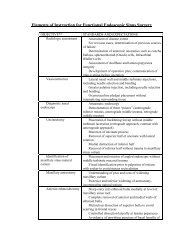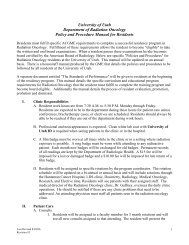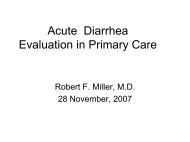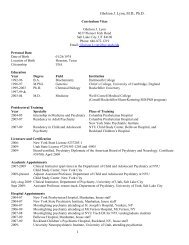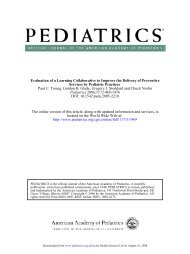Spinal meningiomas: surgical management and outcome
Spinal meningiomas: surgical management and outcome
Spinal meningiomas: surgical management and outcome
You also want an ePaper? Increase the reach of your titles
YUMPU automatically turns print PDFs into web optimized ePapers that Google loves.
<strong>Spinal</strong> <strong>meningiomas</strong> represent 25 to 46% of tumors of<br />
the spine. 9 Typically, they are located in the intradural<br />
extramedullary space, grow slowly, <strong>and</strong> spread laterally<br />
in the subarachnoid space until they induce symptoms.<br />
They most frequently occur in the thoracic region in middle-aged<br />
women. 8,12,13,16,22,25 Patients typically present with<br />
pain, sensory loss, weakness, <strong>and</strong> sphincter disturbances.<br />
Advances in radiological <strong>and</strong> <strong>surgical</strong> assistive devices<br />
(MR imaging, neuromonitoring, intraoperative ultrasonography,<br />
operative microscope, <strong>and</strong> ultrasonic <strong>surgical</strong><br />
aspirator) have resulted in earlier diagnosis <strong>and</strong> aided in<br />
obtaining a total resection. Prognosis in patients with spinal<br />
<strong>meningiomas</strong> is excellent, <strong>and</strong> even patients with a<br />
poor preoperative neurological status can respond favorably<br />
to surgery.<br />
The purpose of this study is threefold. First, we describe<br />
a case of spinal meningioma <strong>and</strong> provide radiological <strong>and</strong><br />
intraoperative findings, as well as a video, demonstrating<br />
the typical presentation <strong>and</strong> <strong>surgical</strong> treatment of spinal<br />
<strong>meningiomas</strong>. Second, we review a recent series of 25 patients<br />
in whom spinal <strong>meningiomas</strong> were resected. Finally,<br />
we review the literature to determine the various <strong>surgical</strong><br />
<strong>management</strong> strategies for spinal <strong>meningiomas</strong>.<br />
CLINICAL MATERIAL AND METHODS<br />
We performed a retrospective chart review of all pa-<br />
Neurosurg Focus 14 (6):Article 2, 2003, Click here to return to Table of Contents<br />
<strong>Spinal</strong> <strong>meningiomas</strong>: <strong>surgical</strong> <strong>management</strong> <strong>and</strong> <strong>outcome</strong><br />
OREN N. GOTTFRIED, M.D., WAYNE GLUF, M.D., ALFREDO QUINONES-HINOJOSA, M.D.,<br />
PETER KAN, M.D., AND MEIC H. SCHMIDT, M.D.<br />
Department of Neurosurgery, University of Utah, Salt Lake City, Utah; <strong>and</strong> Department of<br />
Neurosurgery, University of California, San Francisco, California<br />
Advances in imaging <strong>and</strong> <strong>surgical</strong> technique have improved the treatment of spinal <strong>meningiomas</strong>; these include<br />
magnetic resonance imaging, intraoperative ultrasonography, neuromonitoring, the operative microscope, <strong>and</strong> ultrasonic<br />
cavitation aspirators. This study is a retrospective review of all patients treated at a single institution <strong>and</strong> with a<br />
pathologically confirmed diagnosis of spinal meningioma. Additionally the authors analyze data obtained in 556<br />
patients reported in six large series in the literature, evaluating <strong>surgical</strong> techniques, results, <strong>and</strong> functional <strong>outcome</strong>s.<br />
Overall, <strong>surgical</strong> treatment of spinal <strong>meningiomas</strong> is associated with favorable <strong>outcome</strong>s. <strong>Spinal</strong> <strong>meningiomas</strong> can be<br />
completely resected, are associated with postoperative functional improvement, <strong>and</strong> the rate of recurrence is low.<br />
KEY WORDS • spinal meningioma • spinal tumor • intradural • extramedullary<br />
Abbreviations used in this paper: CSF = cerebrospinal fluid;<br />
MR = magnetic resonance; SSEP = somatosensory evoked potential;<br />
Tc-MEP = transcranial motor evoked potential.<br />
tients in whom a histologically diagnosed meningioma<br />
was resected between 1992 <strong>and</strong> 2002. Of 335 patients who<br />
met these criteria, there were 25 cases (7.5%) of spinal<br />
<strong>meningiomas</strong>. We evaluated the medical records, operative<br />
reports, follow-up information, <strong>and</strong> neuroradiological<br />
findings in these 25 patients. The mean follow-up time<br />
was 23 months (range 1–64 months). Additionally, we<br />
performed a Medline search of articles published between<br />
1982 <strong>and</strong> 2002, using “spinal meningioma” as the key<br />
word. The search turned up six series with a total of 556<br />
patients (Table 1). We combined our series with data obtained<br />
from those in the literature <strong>and</strong> evaluated mode<br />
of presentation, tumor characteristics, <strong>surgical</strong> techniques,<br />
functional <strong>outcome</strong>s, complications, <strong>and</strong> recurrences.<br />
CASE ILLUSTRATION<br />
History <strong>and</strong> Physical Examination. This 77-year-old<br />
man had a 4-month history of numbness in his toes that<br />
progressed to his entire body below the nipple. He also<br />
noted progressive weakness in his lower extremities, gait<br />
instability, inability to ambulate without assistance, <strong>and</strong><br />
urinary <strong>and</strong> fecal incontinence. On examination, 4/5 motor<br />
strength in his right lower extremity <strong>and</strong> 4+/5 motor<br />
strength in his left lower extremity were demonstrated.<br />
Extensor reflexes, clonus, <strong>and</strong> bilateral hyperreflexiveness<br />
were also found bilaterally. A sensory deficit was present<br />
below the T-3 level.<br />
Magnetic resonance imaging revealed a large rightsided<br />
T-2 intradural extramedullary mass that was isointense<br />
to spinal cord on T - (Fig. 1A) <strong>and</strong> T -weighted se-<br />
1 2<br />
quences; homogenous enhancement was apparent after<br />
Neurosurg. Focus / Volume 14 / June, 2003 1
TABLE 1<br />
Summary of demographic data in published series of spinal<br />
<strong>meningiomas</strong> included in the current review<br />
No. of No. of Male/ Mean<br />
Authors & Year Cases Ops Female Age (yrs)<br />
Levy, et al., 1982 97 97 4:1 53<br />
Solero, et al., 1989 174 184 3:1 56<br />
Roux, et al., 1996 54 54 4:1 54<br />
King, et al., 1998 78 78 4.1:1 62<br />
Klekamp & Samii, 1999 117 130 3.9:1 57<br />
Gezen, et al., 2000 36 36 3:1 49<br />
present study, 2003 25 25 4.2:1 60<br />
Gd administration (Fig. 1B). The spinal cord was severely<br />
compressed <strong>and</strong> displaced toward the left (Fig. 1C).<br />
Operation. The patient was positioned prone after<br />
placement of electromyographic <strong>and</strong> SSEP monitoring devices.<br />
After T1–3 laminectomies, the dura mater was<br />
exposed <strong>and</strong> a yellow discoloration was noted. Ultrasonography<br />
confirmed tumor location at the T-2 level. An<br />
operative microscope was used. The dura was incised at<br />
the midline, exposing an extramedullary mass compressing<br />
<strong>and</strong> displacing the spinal cord to the left (Fig. 2 <strong>and</strong><br />
Video). A plane was developed between the normal spinal<br />
cord <strong>and</strong> tumor by performing sharp microdissection. Microscissors,<br />
bipolar cauterization, <strong>and</strong> the ultrasonic <strong>surgical</strong><br />
aspirator were used to debulk the tumor centrally to<br />
achieve decompression. Using the microscissors <strong>and</strong> microdissector,<br />
the tumor <strong>and</strong> its dural attachment at the<br />
right side were removed from the spinal cord. The dural<br />
attachment was thoroughly coagulated using bipolar cauterization.<br />
A gross-total resection was achieved. Finally,<br />
the dura was closed.<br />
Pathological Examination. Microscopic evaluation<br />
demonstrated nests of tumor cells with abundant cyto-<br />
O. N. Gottfried, et al.<br />
Click here to view video clip: Demonstrated in the video clip<br />
is the resection of a T-2 intradural extramedullary spinal meningioma.<br />
Note that the meningioma is located at the superior aspect<br />
of the screen <strong>and</strong> the spinal cord is inferior to this tumor. First, a<br />
plane is developed between the normal spinal cord <strong>and</strong> tumor by<br />
using sharp microdissection. The tumor is then internally debulked<br />
using bipolar cauterization, microscissors, <strong>and</strong> the <strong>surgical</strong> ultrasonic<br />
aspirator. After this, the meningioma is carefully rolled away<br />
from the spinal cord toward its dural attachment. Finally, using microscissors,<br />
the tumor capsule is resected from its dural attachment<br />
<strong>and</strong> the dura is coagulated to remove additional tumor cells. At the<br />
conclusion, the dural is closed primarily.<br />
plasm <strong>and</strong> bl<strong>and</strong> oval nuclei. There were occasional psammoma<br />
bodies. The findings were consistent with spinal<br />
meningioma.<br />
Postoperative Course. The patient remained supine for<br />
48 hours after surgery. Postoperative MR imaging revealed<br />
no evidence of residual tumor. Prior to discharge<br />
from the hospital on postoperative Day 4, he ambulated<br />
with a cane, <strong>and</strong> lower-extremity strength <strong>and</strong> sensation<br />
had improved. He benefited from a short stay in the inpatient<br />
rehabilitation unit. Two months after surgery, the patient<br />
had regained full urinary <strong>and</strong> bowel continence,<br />
ambulated without an assistive device, <strong>and</strong> exhibited normal<br />
motor strength with only mild residual numbness in<br />
his toes.<br />
SPINAL MENINGIOMAS: MANAGEMENT AND<br />
OUTCOME<br />
Epidemiological Features<br />
The annual incidence of primary intraspinal neoplasm<br />
is approximately five per million for females <strong>and</strong> three per<br />
million for males. 9 <strong>Spinal</strong> intradural extramedullary tumors<br />
account for two thirds of all intraspinal neoplasms<br />
<strong>and</strong> include neuromas <strong>and</strong> <strong>meningiomas</strong>. 1 Overall, <strong>meningiomas</strong><br />
account for 25 to 46% of primary spinal neo-<br />
Fig. 1. A <strong>and</strong> B: Sagittal T 1 -weighted MR images of the thoracic spine before (A) <strong>and</strong> after (B) Gd administration<br />
demonstrating an intradural extramedullary, isointense meningioma at T-2 that homogenously enhances. C: Axial<br />
image revealing that the mass severely compresses <strong>and</strong> displaces the spinal cord (arrowhead) to the left.<br />
2 Neurosurg. Focus / Volume 14 / June, 2003
<strong>Spinal</strong> <strong>meningiomas</strong><br />
Fig. 2. Intraoperative photograph obtained using the operative<br />
microscope demonstrating the intradural extamedullary meningioma<br />
attached to the lateral dura surface <strong>and</strong> severely compressing<br />
the spinal cord.<br />
plasms <strong>and</strong> are the second most common intradural spine<br />
tumor after neuromas. 9 <strong>Spinal</strong> <strong>meningiomas</strong> occur less<br />
frequently than intracranial ones <strong>and</strong> account for approximately<br />
7.5 to 12.7% of all <strong>meningiomas</strong>. 25<br />
<strong>Spinal</strong> <strong>meningiomas</strong> most often affect middle-aged<br />
women. The female/male ratio is overrepresented compared<br />
with intracranial <strong>meningiomas</strong>. We found the<br />
female/male ratio in the present review to be between 3<br />
<strong>and</strong> 4.2:1 (mean age range 49–62 years [Table 1]). It has<br />
been suggested that spinal <strong>meningiomas</strong> occur more frequently<br />
in women because of a possible dependence on<br />
sex hormones. 20,25 Although the effect of sex hormones<br />
on <strong>meningiomas</strong> is controversial, the authors of hormone<br />
studies have shown the existence of various other receptor<br />
types (steroid, peptidergic, growth factor, <strong>and</strong> aminergic)<br />
that may contribute to tumor formation. 20<br />
Genetic Alterations<br />
In genetic studies investigators have shown complete<br />
or partial loss of chromosome 22 in greater than 50% of<br />
patients with spinal <strong>meningiomas</strong>. 2,11 Arslantas, et al., 2 reported<br />
abnormalities of cancer-related genes located on<br />
1p, 9p, 10q, <strong>and</strong> 17q in spinal <strong>meningiomas</strong> <strong>and</strong> concluded<br />
that they might be involved in the cause of spinal <strong>meningiomas</strong>.<br />
Interestingly, Ketter, et al., 11 stated that all<br />
spinal <strong>meningiomas</strong> in their series (23 of 198) had a normal<br />
chromosomal set or a monosomy of 22. This genotype<br />
was not associated with disease recurrence, in contrast<br />
to intracranial <strong>meningiomas</strong>, which had a higher rate<br />
of tumors with multiple chromosomal aberrations, correlating<br />
with higher rates of recurrences.<br />
Tumor Locations<br />
In this review, the most frequent location of spinal <strong>meningiomas</strong><br />
was the thoracic region (67–84%) (Table 2).<br />
They occurred far less frequently in the cervical spine<br />
(14–27%) <strong>and</strong> only rarely in the lumbar spine (2–14%).<br />
Cohen-Gadol, et al., 3 found that in patients younger than<br />
50 years of age there tended to be a higher frequency<br />
(39%) of spinal <strong>meningiomas</strong> located in the cervical<br />
spine, <strong>and</strong> the majority were located in the high cervical<br />
Neurosurg. Focus / Volume 14 / June, 2003<br />
TABLE 2<br />
Location <strong>and</strong> relation of tumor to the spinal cord<br />
<strong>Spinal</strong> Cord Location (%) Relation to Spine (%)<br />
Cer- Tho- Lum- Pos- An-<br />
Authors & Year vical racic bar Lat terior terior<br />
Levy, et al., 1982 17 75 7 13 51† 36†<br />
Solero, et al., 1989 15 83 2 68 18 15<br />
Roux, et al., 1996 18 80 2 22 33† 39†<br />
King, et al., 1998 14 84 2 71 10 19<br />
Klekamp & Samii, 1999 27 67 6 45 28 27<br />
Gezen, et al., 2000 14 72* 14 50 31 19<br />
present study, 2003 16 76 8 48 36 16<br />
* Including cervicothoracic <strong>and</strong> thoracolumbar <strong>meningiomas</strong>.<br />
† Including posterolateral <strong>and</strong> anterolateral tumors.<br />
region. Levy, et al., 16 reported that tumor location varied<br />
according to sex, with significantly more thoracic spine<br />
<strong>meningiomas</strong> appearing in female patients. In addition,<br />
they found that cervical <strong>meningiomas</strong> were more likely to<br />
be located ventral to the cord.<br />
We found that spinal <strong>meningiomas</strong> were located lateral<br />
to the spinal cord or had a component that extended laterally<br />
(Table 2). A posterior location was more frequent than<br />
an anterior one.<br />
<strong>Spinal</strong> <strong>meningiomas</strong> were typically intradural <strong>and</strong> extramedullary<br />
(83–94%). In our series, all 25 patients harbored<br />
intradural extramedullary <strong>meningiomas</strong>, whereas in<br />
the reviewed series 5 to 14% of tumors had an extradural<br />
component. 8,12,13,16,22,25 There were several cases of entirely<br />
extradural <strong>meningiomas</strong> (3–9%). 12,22,25<br />
Diagnostic Evaluation <strong>and</strong> Imaging<br />
There was typically a delay between the onset of symptoms<br />
<strong>and</strong> diagnosis. The mean duration of symptoms prior<br />
to presentation was 1 to 2 years. 12,13,16,22 In the present series<br />
<strong>and</strong> in the literature, some patients noted pain symptoms<br />
beginning 15 to 20 years prior to diagnosis of spinal<br />
meningioma. 16 Patients often presented with pain, sensorimotor<br />
deficits, <strong>and</strong> sphincter disturbances (Table 3). Typically,<br />
back or radicular pain preceded the weakness <strong>and</strong><br />
sensory changes; the sphincter dysfunction was always a<br />
late finding. Additionally, signs of myelopathy were present<br />
in most patients. In our series, weakness was present<br />
TABLE 3<br />
Symptoms <strong>and</strong> signs of spinal <strong>meningiomas</strong>*<br />
Presenting Symptom (%)<br />
Sphincter<br />
Authors & Year Pain Weakness Sensory Dysfunction<br />
Levy, et al., 1982 77 66 74 40<br />
Solero, et al., 1989 53 92 61 50<br />
Roux, et al., 1996 72 80 67 37<br />
King, et al., 1998 23† NA 28† 61<br />
Klekamp & Samii, 1999 50† 16† 6† 6†<br />
Gezen, et al., 2000 83 83 50 36<br />
present study, 2003 68 64 84 48<br />
* NA = not applicable.<br />
† Values reflect first symptom.<br />
3
in 64%, <strong>and</strong> 32% of the patients were nonambulatory at<br />
the time of presentation.<br />
Prior to the advent of MR imaging, spinal <strong>meningiomas</strong><br />
were often confused with multiple sclerosis, syringomyelia,<br />
pernicious anemia, <strong>and</strong> herniated disc. 8,16 Levy, et<br />
al., 16 reported that the rate of misdiagnosis in their pre–<br />
MR imaging series was 33% <strong>and</strong> that errors in diagnosis<br />
delayed treatment, sometimes leading to inappropriate<br />
surgery. Seven of their patients underwent inappropriate<br />
surgeries, including lumbar disc exploration <strong>and</strong> knee surgery.<br />
In our series, a misdiagnosis of multiple sclerosis<br />
was made in one case <strong>and</strong> arthritis in another.<br />
Magnetic resonance imaging is the best imaging technique<br />
for diagnosing spinal <strong>meningiomas</strong>. It clearly delineates<br />
the level of the tumor <strong>and</strong> its relation to the cord,<br />
which is useful in planning surgery. In the past, plain radiography<br />
was used to detect calcified <strong>meningiomas</strong>, but<br />
calcifications are only visible on 2 to 5% of plain x-ray<br />
films. 25 Prior to the advent of MR imaging, myelography<br />
was the radiological modality of choice. 16,25 Klekamp <strong>and</strong><br />
Samii 13 reported that MR imaging led to earlier diagnosis<br />
of spinal <strong>meningiomas</strong> by 6 months <strong>and</strong>, on average, patients<br />
suffered less severe neurological deficits at the time<br />
of surgery. Typically, spinal <strong>meningiomas</strong> were isointense<br />
to the normal spinal cord on T 1 - <strong>and</strong> T 2 -weighted images,<br />
<strong>and</strong> they displayed intense enhancement after gadolinium<br />
injection. 8<br />
Intraoperative ultrasonography has been useful in the<br />
identification <strong>and</strong> localization of <strong>meningiomas</strong>, 17 providing<br />
useful information about its size <strong>and</strong> the degree to<br />
which it displaces the spinal cord. Typical ultrasonographic<br />
features include echogenicity, irregular surfaces,<br />
<strong>and</strong> tight adherence to the dura. 17<br />
Surgical Approach<br />
In the reviewed series, all patients underwent classic<br />
posterior laminectomies. In cases in which <strong>meningiomas</strong><br />
were located anteriorly the laminectomy was extended laterally<br />
toward the articular process to provide sufficient<br />
exposure <strong>and</strong> cause minimal displacement of the spinal<br />
cord. Excluding those in the earlier series, patients underwent<br />
surgeries involving the operating microscope (Table<br />
4). Ultrasonography provided detailed localization of<br />
<strong>meningiomas</strong>, thereby avoiding unnecessarily large dural<br />
openings. The goal of surgery was to minimize displacement<br />
of the spinal cord by undertaking an appropriately<br />
TABLE 4<br />
Surgical equipment <strong>and</strong> percent of complete resections*<br />
Op Device (%)<br />
Micro- US Total Re-<br />
Authors & Year scope Aspirator Laser section (%)<br />
Levy, et al., 1982 NA NA NA 82<br />
Solero, et al., 1989 17 NA NA 97<br />
Roux, et al., 1996 63 18 22 93<br />
King, et al., 1998 NA NA NA 99<br />
Klekamp & Samii, 1999 NA NA NA 89<br />
Gezen, et al., 2000 100 NA NA 97<br />
present study, 2003<br />
* US = ultrasonic <strong>surgical</strong>.<br />
100 63 4 92<br />
O. N. Gottfried, et al.<br />
wide exposure, making the tumor <strong>and</strong> its dural attachment<br />
accessible. Sometimes this was accomplished by cutting<br />
one or more dentate ligaments. After dural opening, a<br />
plane was developed between the arachnoid <strong>and</strong> the tumor.<br />
The tumor was then internally debulked using suction,<br />
an ultrasonic <strong>surgical</strong> aspirator, microscissors, or<br />
laser. In the more recent series, increased use of the ultrasonic<br />
<strong>surgical</strong> aspirator <strong>and</strong> laser was apparent. After<br />
debulking, in the majority of cases the tumor was rolled<br />
away from the spinal cord <strong>and</strong> toward its dural attachment.<br />
The tumor was then removed from its dural attachment.<br />
Dura with remaining tumor was either coagulated<br />
using bipolar cauterization or resected (Table 5). In the<br />
majority of cases, including our series, the dural attachment<br />
was cauterized rather than resected. The dural attachment<br />
was always cauterized in cases involving an<br />
anterior dural attachment. Additionally, in most cases the<br />
dura was closed primarily, compared with suturing in a<br />
graft, which was performed far less frequently (Table 5).<br />
Another option was separation of the dura into an outer<br />
<strong>and</strong> inner layer <strong>and</strong> to resect the tumor with the inner layer,<br />
leaving the outer layer available for closure. 23<br />
Neuromonitoring Techniques<br />
Neuromonitoring may reduce the likelihood of postoperative<br />
neurological deficits as a result of resecting spinal<br />
cord <strong>meningiomas</strong>. This modality provides data on the<br />
extent of tissue manipulation, does not compromise function,<br />
<strong>and</strong> may potentially lead to preservation of function;<br />
the benefits justify its use <strong>and</strong> the risks associated with<br />
extended operating time. Two commonly used modalities<br />
described in the reviewed series were muscle Tc-MEP <strong>and</strong><br />
SSEP monitoring. Transcranial-MEPs were obtained by<br />
placing stimulating electrodes over the patient’s motor<br />
cortical regions <strong>and</strong> recording electromyographic activity<br />
either epidurally or at the extremities. 14 This method was<br />
useful for tumors involving the anterior <strong>and</strong>/or anterolateral<br />
spinal canal <strong>and</strong> compressing of the corticospinal<br />
tracts. The SSEP recordings were useful in tumors located<br />
in the posterior or posterolateral aspect of the canal <strong>and</strong><br />
compressing the dorsal columns.<br />
The advantage of muscle Tc-MEP monitoring is that it<br />
allows assessment of motor function from the cortex to<br />
beyond the neuromuscular junction. The Tc-MEPs were<br />
TABLE 5<br />
Approaches to dural attachment <strong>and</strong> dural closure<br />
Resection (%) Dural Repair (%)<br />
Coagu- Primary<br />
Authors & Year Dural lation Closure Graft<br />
Levy, et al., 1982 57 15 15 8*<br />
Solero, et al., 1989 14 86 86 14<br />
Roux, et al., 1996 15 85 89 11<br />
King, et al., 1998 26 74 NA NA<br />
Klekamp & Samii, 1999 NA NA NA NA<br />
Gezen, et al., 2000 NA NA NA NA<br />
present study, 2003 16† 88 88 12<br />
* Performed in 77% of patients with the dura left open.<br />
† One patient underwent a split-thickness removal of dura followed by<br />
coagulation.<br />
4 Neurosurg. Focus / Volume 14 / June, 2003
<strong>Spinal</strong> <strong>meningiomas</strong><br />
recorded directly in the muscles being assessed. In addition,<br />
muscle Tc-MEPs can be recorded from all four individual<br />
extremities, allowing evaluation of the extremity<br />
most affected by <strong>surgical</strong> manipulation. One limitation of<br />
this modality in the reviewed series was that the potentials<br />
were often blocked after induction of general anesthesia. 30<br />
The use of a multiple impulse technique (short train of<br />
stimuli) helped resolve this problem. The Tc-MEPs induced<br />
by multiple stimuli were much less sensitive to the<br />
effects of general anesthesia than those evoked by a single<br />
stimulus. 10,21,27<br />
Somatosensory evoked potentials were traditionally<br />
used by various investigators to evaluate cerebral function<br />
in procedures involving intracranial aneurysms <strong>and</strong> tumors.<br />
6,7,19,24,28 Recently, its utility has been extended to the<br />
resection of intramedullary spinal cord tumors <strong>and</strong> extraaxial<br />
spinal cord tumors. This monitoring modality consists<br />
of stimulating the median <strong>and</strong> tibial nerves bilaterally<br />
<strong>and</strong> recording orthodromic SSEPs from both cortical<br />
<strong>and</strong> spinal epidural electrodes throughout the procedure. 14<br />
When spinal <strong>meningiomas</strong> were resected, this monitoring<br />
was used to detect changes in the SSEP responses as a<br />
real-time feedback for the surgeon. Manipulation of the<br />
spinal cord can lead to changes in SSEP signals <strong>and</strong><br />
prompt the surgeon to decrease manipulation or to change<br />
techniques such as retraction. This feedback is relevant in<br />
the thoracic spine where space was limited. Somatosensory<br />
evoked potentials can be recorded throughout surgery<br />
without risk of patient movement <strong>and</strong> correlated with<br />
postoperative sensory findings, particularly proprioception<br />
(joint position sense). 14 Unfortunately, SSEPs are<br />
fragile monitored circuits <strong>and</strong> lack correlation with postoperative<br />
motor function. 29 During resection of spinal <strong>meningiomas</strong>,<br />
motor <strong>and</strong> sensory pathways could be affected<br />
separately. 26 Several groups reported postoperative motor<br />
deficits despite recording normal intraoperative SSEPs<br />
during tumor resection. 15,31<br />
Histopathological Characteristics<br />
The most common histological features of spinal meningioma<br />
include meningotheliomatous, fibroblastic, transitional,<br />
<strong>and</strong> psammomatous. 8,12,13,16,22,25 Meningotheliomatous<br />
<strong>and</strong> psammomatous types were the predominant<br />
histopathological lesions. 8,12,13,16,22,25 The histological type<br />
did not seem to influence prognosis, except if malignancy<br />
was evident. 12,22,25<br />
Surgical Results<br />
Complete resection was achieved in 82 to 99% of cases<br />
(Table 4). 8,12,13,16,22,25 In our series, total resection was<br />
achieved in 23 (92%) of 25 patients. Of the two subtotal<br />
resections, one was performed in a patient with a large,<br />
calcified anterior C2–5 spinal meningioma. The surgery<br />
was complicated by extensive calcifications <strong>and</strong> by the<br />
tumor’s adherence to the dura <strong>and</strong> its anterior extension.<br />
The other subtotal resection was performed in a patient<br />
with a large meningioma extending from T-12 to L-2 that<br />
diffusely infiltrated the conus medullaris.<br />
In general, anterior, en plaque, recurrent tumors with<br />
arachnoid scarring <strong>and</strong> calcified <strong>meningiomas</strong> were implicated<br />
as potential challenges for total resection. 13,16,22,25<br />
The benefits of complete resection need to be weighed<br />
Neurosurg. Focus / Volume 14 / June, 2003<br />
against the potential for spinal cord damage. In the reviewed<br />
series, the main technical challenge involving<br />
anterior <strong>meningiomas</strong> was gaining access to the tumor <strong>and</strong><br />
its attachment. En plaque <strong>meningiomas</strong> were a <strong>surgical</strong><br />
challenge because they did not respect tissue planes, had<br />
a more extensive tumor matrix, infiltrated surrounding<br />
structures, <strong>and</strong> occasionally showed ossifications. 5,13 Klekamp<br />
<strong>and</strong> Samii 13 reported that only 53% of en plaque<br />
tumors were completely resected compared with 97% of<br />
encapsulated <strong>meningiomas</strong>. In surgery for recurrent lesions,<br />
arachnoid scarring complicating the procedure was<br />
found in 90% of cases compared with 11% in primary<br />
<strong>meningiomas</strong>. 13 Surgery for recurrent <strong>meningiomas</strong> was<br />
difficult because adhesions caused cord tethering; difficulty<br />
in distinguishing between scar, meningioma, <strong>and</strong><br />
spinal cord; absence of an arachnoidal interface; <strong>and</strong> in<br />
some cases pia infiltration. 13 Klekamp <strong>and</strong> Samii reported<br />
that only 45% of recurrent tumors were completely resected<br />
compared with 95% of the first operations; additionally<br />
only tumors in cases involving arachnoid scarring were<br />
completely resected in only 70%, whereas in the absence<br />
of scarring complete excision was possible in 94%. They<br />
recommended sharp dissection of arachnoid scars, meticulous<br />
hemostasis, <strong>and</strong> decompression of the subarachnoid<br />
space by placing a dural graft, providing protection<br />
against significant postoperative tethering <strong>and</strong> CSF<br />
obstruction. Calcified <strong>meningiomas</strong> were also difficult to<br />
resect because of adhesions to the spinal cord. 5,16,22 Levy,<br />
et al., 16 reported poor functional <strong>outcome</strong>s in three of four<br />
patients harboring calcified tumors; the patients became<br />
paraplegic as a result of the additional manipulations required<br />
to dissect the tumor.<br />
Some authors of the reviewed series believed that epidural<br />
<strong>meningiomas</strong> 16 <strong>and</strong> <strong>meningiomas</strong> located close to a<br />
radicomedullary artery 22 may represent <strong>surgical</strong> challenges.<br />
It was thought that spinal <strong>meningiomas</strong> with epidural<br />
extension exhibited a more rapid clinical course <strong>and</strong><br />
were more invasive. 16 Others argued that these lesions<br />
did not represent a unique subgroup <strong>and</strong> had an indolent<br />
course. 22,25 Roux, et al., 22 asserted that total resection of<br />
spinal <strong>meningiomas</strong> in proximity to a radicomedullary<br />
artery feeding the anterior spinal artery was dangerous,<br />
<strong>and</strong> they advocated the use of spinal angiography in all<br />
patients. One patient in their series suffered permanent<br />
postoperative paraplegia due to anterior spinal artery<br />
ischemia.<br />
Functional Outcome<br />
Overall, functional improvement occurred in 53 to 95%<br />
of cases <strong>and</strong> neurological deterioration was demonstrated<br />
in 0 to 10% (Table 6). 8,12,13,16,22,25 The mean follow-up intervals<br />
ranged from 20 to 180 months. In our review we<br />
found that even patients with severe preoperative neurological<br />
deficits may experience a full neurological recovery<br />
after careful <strong>surgical</strong> interventions <strong>and</strong> appropriate<br />
rehabilitation. 13,16 For example, King, et al., 12 found that<br />
three of four patients with preoperative paraplegia were<br />
independently mobile <strong>and</strong> asymptomatic in the postoperative<br />
period. Overall the majority of patients, (75–97%)<br />
were ambulatory postoperatively, whereas before surgery<br />
33 to 74% of patients were able to walk (Table 6). King,<br />
et al., 12 found that 35 (95%) of 37 patients with preopera-<br />
5
TABLE 6<br />
Functional <strong>outcome</strong>s after surgery for spinal <strong>meningiomas</strong><br />
Outcome (%)<br />
Ambulatory (%)<br />
Im- Dete-<br />
Authors & Year proved Stable riorated Preop Postop<br />
Levy, et al., 1982 83 17 0 70 76<br />
Solero, et al., 1989 53 37 10 70 92<br />
Roux, et al., 1996 85 13 2 67 94<br />
King, et al., 1998 95 1 4 74 97<br />
Klekamp & Samii, 1999 NA NA NA 74 94<br />
Gezen, et al., 2000 83 14 3 33 75<br />
present study, 2003 92 0 8 68 96<br />
tive bladder dysfunction exhibited normal function after<br />
surgery. Some patients suffered transient neurological<br />
worsening postoperatively, typically secondary to vasogenic<br />
edema or as a result of dissection, but function generally<br />
recovered after 6 months. 13,22,25<br />
Surgical Complications<br />
Mortality <strong>and</strong> morbidity rates were low. In published<br />
studies, the mortality rate ranged from 0 to 3% (Table 7),<br />
<strong>and</strong> the cause of death was unrelated to the primary disease<br />
in all cases reviewed. Causes of death in the reviewed<br />
series included pulmonary embolism, aspiration pneumonia,<br />
stroke, <strong>and</strong> myocardial infarction. 12,13,16,25 The incidence<br />
of CSF leakage was low (0–4%).<br />
Tumor Recurrence<br />
Recurrence of spinal <strong>meningiomas</strong> was rare, <strong>and</strong> in<br />
most series the rate ranged from 1.3 to 6.4% (Table<br />
7). 8,12,16,22,25 Ketter, et al., 11 reported that spinal <strong>meningiomas</strong><br />
did not have the genetic abnormalities found in recurrent<br />
intracranial <strong>meningiomas</strong>, suggesting that they had a<br />
more indolent nature. The slow growth of spinal <strong>meningiomas</strong><br />
<strong>and</strong> their presentation in patients at a late age contributed<br />
to the low recurrence rates. 12 In the reviewed series,<br />
recurrences occurred at 1 to 17 years (Table 7). In our<br />
series, one patient (4%) suffered a recurrence 2 years after<br />
subtotal resection of a large, infiltrative conus medullaris<br />
meningioma.<br />
Significantly higher recurrence rates were found in<br />
TABLE 7<br />
Surgical morbidity <strong>and</strong> mortality <strong>and</strong> the rate/timing of recurrence*<br />
O. N. Gottfried, et al.<br />
cases involving en plaque or infiltrating <strong>meningiomas</strong>,<br />
tumors with arachnoid scarring, <strong>and</strong> in partially resected<br />
lesions. 13 Klekamp <strong>and</strong> Samii 13 stated that in patients in<br />
whom complete resection, was performed, 29.5% experienced<br />
a recurrance within 5 years of surgery, whereas in<br />
all patients with partially removed tumors the lesion had<br />
recurred by that time. In general, the course of a spinal<br />
meningioma appeared to be more benign than its intracranial<br />
counterpart. Mirimanoff, et al., 18 reported a recurrence<br />
rate of 13% at 10 years, which was far lower than<br />
those reported for convexity <strong>meningiomas</strong> (3 <strong>and</strong> 25%<br />
after 5 <strong>and</strong> 10 years, respectively) <strong>and</strong> parasagittal <strong>meningiomas</strong><br />
(18 <strong>and</strong> 24% after 5 <strong>and</strong> 10 years). Unlike intracranial<br />
<strong>meningiomas</strong>, there was no correlation between<br />
recurrence <strong>and</strong> the resection of dural attachment. 8,12,13,25<br />
Comparing radical dural resection <strong>and</strong> dural coagulation,<br />
Solero, et al., 25 reported recurrence rates of 8 <strong>and</strong> 5.6%,<br />
Levy, et al., 16 reported 4 <strong>and</strong> 0%, <strong>and</strong> Klekamp <strong>and</strong> Samii<br />
reported 31.3 <strong>and</strong> 26.1%, respectively.<br />
Cohen-Gadol, et al., 3 found that rates of recurrence <strong>and</strong><br />
reoperation in patients younger than 50 years of age were<br />
higher than those in older patients because of a higher frequency<br />
of spinal <strong>meningiomas</strong> with cervical spine locations,<br />
extradural tumor extension, <strong>and</strong> en plaque growth,<br />
all of which made total resection more difficult. Deen, et<br />
al., 4 also reported a higher rate of recurrence (20%) in patients<br />
younger than 21 years of age.<br />
Adjunctive Radiotherapy<br />
Although the optimal treatment for primary spinal meningioma<br />
was total micro<strong>surgical</strong> resection, some authors<br />
advocated adjunctive radiotherapy in cases of recurrent<br />
tumors. 8,22 Its role as adjuvant therapy after subtotal resection<br />
was controversial because of the tumor’s typically<br />
indolent nature. 8,22 It has been indicated that radiotherapy<br />
should be considered after subtotal primary excision in<br />
cases of recurrent <strong>meningiomas</strong>, or as an alternative to<br />
surgery when the operative risk is too high because of<br />
comorbidities or tumor location. 8,18,22 Surgery for recurrent<br />
spinal <strong>meningiomas</strong> was performed before radiotherapy if<br />
the tumor was accessible. 8,18,22 Gezen, et al., 8 reported no<br />
recurrence in the two patients who underwent radiotherapy<br />
for recurrent spinal meningioma. Roux, et al., 22 also<br />
performed radiosurgery in two patients with recurrences,<br />
<strong>and</strong> the patients were stable at a follow-up examination<br />
Morbidity (%)<br />
Recurrence<br />
Mortality CSF Wound Mean<br />
Authors & Year (%) Leak Infection FU (mos) Incidence Timing (yrs)<br />
Levy, et al., 1982 1 3 1 84 3.1 8–16<br />
Solero, et al., 1989 1 1 1 180 6.4 1–17<br />
Roux, et al., 1996 0 0 1 28 3.7 2<br />
King, et al., 1998 1 4 0 132† 1.3 14<br />
Klekamp & Samii, 1999 2 4 1 20 14.7 NA<br />
Gezen, et al., 2000 3 3 6 108 5.6 5–8<br />
present study, 2003 0 0 0 23 4.0 2<br />
* FU = follow up.<br />
† Value represents the median number of follow-up months.<br />
6 Neurosurg. Focus / Volume 14 / June, 2003
<strong>Spinal</strong> <strong>meningiomas</strong><br />
after 5 years. In our series, the one patient in whom recurrence<br />
was demonstrated underwent radiotherapy, leading<br />
to decreased tumor size <strong>and</strong> stabilization of neurological<br />
function. Overall, one can anticipate that new radiosurgery<br />
techniques will be useful in the treatment of recurrent<br />
spinal <strong>meningiomas</strong>.<br />
CONCLUSIONS<br />
Surgery is the preferred treatment in cases of spinal<br />
<strong>meningiomas</strong> because of its associated excellent functional<br />
improvement <strong>and</strong> low recurrence rates. Radiosurgery<br />
should be considered for the exceptional case involving<br />
recurrent <strong>and</strong> symptomatic spinal <strong>meningiomas</strong>.<br />
Acknowledgments<br />
The author would like to thank Jenny Ridenour for her excellent<br />
technical assistance <strong>and</strong> Sacha Hwang for editorial assistance.<br />
References<br />
1. Albanese V, Platania N: <strong>Spinal</strong> intradural extramedullary tumors.<br />
Personal experience. J Neurosurg Sci 46:18–24, 2002<br />
2. Arslantas A, Artan S, Oner U, et al: Detection of chromosomal<br />
imbalances in spinal <strong>meningiomas</strong> by comparative genomic hybridization.<br />
Neurol Med Chir 43:12–19, 2003<br />
3. Cohen-Gadol AA, Zikel OM, Koch CA, et al: <strong>Spinal</strong> <strong>meningiomas</strong><br />
in patients younger than 50 years of age: a 21-year experience.<br />
J Neurosurg (Spine 3) 98:258–263, 2003<br />
4. Deen HG Jr, Scheithauer BW, Ebersold MJ: Clinical <strong>and</strong> pathological<br />
study of <strong>meningiomas</strong> of the first two decades of life. J<br />
Neurosurg 56:317–322, 1982<br />
5. Freidberg SR: Removal of an ossified ventral thoracic meningioma.<br />
Case report. J Neurosurg 37:728–730, 1972<br />
6. Friedman WA, Chadwick GM, Verhoeven FJ, et al: Monitoring<br />
somatosensory evoked potentials during surgery for middle cerebral<br />
artery aneurysms. Neurosurgery 29:83–88, 1991<br />
7. Friedman WA, Kaplan BL, Day AL, et al: Evoked potential<br />
monitoring during aneurysm operation: observations after fifty<br />
cases. Neurosurgery 20:678–687, 1987<br />
8. Gezen F, Kahraman S, Canakci Z, et al: Review of 36 cases of<br />
spinal cord meningioma. Spine 25:727–731, 2000<br />
9. Helseth A, Mork SJ: Primary intraspinal neoplasms in Norway,<br />
1955 to 1986. A population-based survey of 467 patients. J<br />
Neurosurg 71:842–845, 1989<br />
10. Jones SJ, Harrison R, Koh KF, et al: Motor evoked potential<br />
monitoring during spinal surgery: responses of distal limb muscles<br />
to transcranial cortical stimulation with pulse trains. Electroencephalogr<br />
Clin Neurophysiol 100:375–383, 1996<br />
11. Ketter R, Henn W, Niedermayer I, et al: Predictive value of progression-associated<br />
chromosomal aberrations for the prognosis<br />
of <strong>meningiomas</strong>: a retrospective study of 198 cases. J Neurosurg<br />
95:601–607, 2001<br />
12. King AT, Sharr MM, Gullan RW, et al: <strong>Spinal</strong> <strong>meningiomas</strong>: a<br />
20-year review Br J Neurosurg 12:521–526, 1998<br />
13. Klekamp J, Samii M: Surgical results for spinal <strong>meningiomas</strong>.<br />
Surg Neurol 52:552–562, 1999<br />
14. Kothbauer K, Deletis V, Epstein FJ: Intraoperative spinal cord<br />
monitoring for intramedullary surgery: an essential adjunct.<br />
Neurosurg. Focus / Volume 14 / June, 2003<br />
Pediatr Neurosurg 26:247–254, 1997<br />
15. Lesser RP, Raudzens P, Luders H, et al: Postoperative neurological<br />
deficits may occur despite unchanged intraoperative somatosensory<br />
evoked potentials. Ann Neurol 19:22–25, 1986<br />
16. Levy WJ Jr, Bay J, Dohn D: <strong>Spinal</strong> cord meningioma. J Neurosurg<br />
57:804–812, 1982<br />
17. Mimatsu K, Kawakami N, Kato F, et al: Intraoperative ultrasonography<br />
of extramedullary spinal tumours. Neuroradiology<br />
34:440–443, 1992<br />
18. Mirimanoff RO, Dosoretz DE, Linggood RM, et al: Meningioma:<br />
analysis of recurrence <strong>and</strong> progression following neuro<strong>surgical</strong><br />
resection. J Neurosurg 62:18–24, 1985<br />
19. Mizoi K, Yoshimoto T: Permissible temporary occlusion time<br />
in aneurysm surgery as evaluated by evoked potential monitoring.<br />
Neurosurgery 33:434–440, 1993<br />
20. Parisi JE, Mena H: Nonglial tumors, in Nelson JS, Parisi JE,<br />
Schochet SS Jr (eds): Principles <strong>and</strong> Practice of Neuropathology.<br />
St Louis: Mosby, 1993, pp 203–266<br />
21. Pechstein U, Cedzich C, Nadstawek J, et al: Transcranial highfrequency<br />
repetitive electrical stimulation for recording myogenic<br />
motor evoked potentials with the patient under general<br />
anesthesia. Neurosurgery 39:335–344, 1996<br />
22. Roux FX, Nataf F, Pinaudeau M, et al: Intraspinal <strong>meningiomas</strong>:<br />
review of 54 cases with discussion of poor prognosis<br />
factors <strong>and</strong> modern therapeutic <strong>management</strong>. Surg Neurol 46:<br />
458–464, 1996<br />
23. Saito T, Arizono T, Maeda T, et al: A novel technique for <strong>surgical</strong><br />
resection of spinal meningioma. Spine 26:1805–1808,<br />
2001<br />
24. Schramm J, Koht A, Schmidt G, et al: Surgical <strong>and</strong> electrophysiological<br />
observations during clipping of 134 aneurysms with<br />
evoked potential monitoring. Neurosurgery 26:61–70, 1990<br />
25. Solero CL, Fornari M, Giombini S, et al: <strong>Spinal</strong> <strong>meningiomas</strong>:<br />
review of 174 operated cases. Neurosurgery 25:153–160,<br />
1989<br />
26. Steinbok P, Cochrane DD, Poskitt K: Intramedullary spinal<br />
cord tumors in children. Neurosurg Clin N Am 3:931–945,<br />
1992<br />
27. Taniguchi M, Cedzich C, Schramm J: Modification of cortical<br />
stimulation for motor evoked potentials under general anesthesia:<br />
technical description. Neurosurgery 32:219–226, 1993<br />
28. Wagner W, Peghini-Halbig L, Maurer JC, et al: Intraoperative<br />
SEP monitoring in neurosurgery around the brain stem <strong>and</strong> cervical<br />
spinal cord: differential recording of subcortical components.<br />
J Neurosurg 81:213–220, 1994<br />
29. Whittle IR, Johnston IH, Besser M: Recording of spinal somatosensory<br />
evoked potentials for intraoperative spinal cord<br />
monitoring. J Neurosurg 64:601–612, 1986<br />
30. Zhou HH, Mehta M, Leis AA: <strong>Spinal</strong> cord motoneuron excitability<br />
during isoflurane <strong>and</strong> nitrous oxide anesthesia. Anesthesiology<br />
86:302–307, 1997<br />
31. Zornow MH, Grafe MR, Tybor C, et al: Preservation of evoked<br />
potential in a case of anterior spinal artery syndrome. Electroencephalogr<br />
Clin Neurophysiol 77:137–139, 1990<br />
Manuscript received April 16, 2003.<br />
Accepted in final form May 8, 2003.<br />
Address reprint requests to: Meic H. Schmidt, M.D., Department<br />
of Neurosurgery, University of Utah Medical Center, 30 North<br />
1900 East, Suite 3B409, Salt Lake City, Utah 84132. email:<br />
Meic.Schmidt@hsc.utah.edu.<br />
7
Author Names, et al.<br />
8 Neurosurg. Focus / Volume 14 / June, 2003


